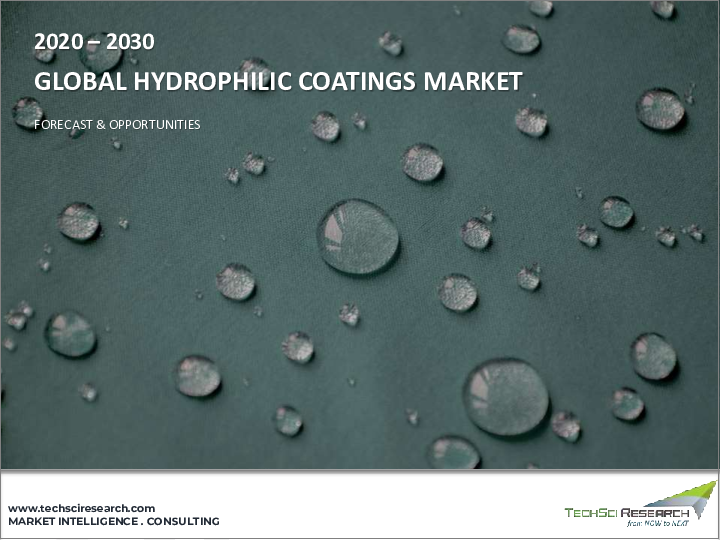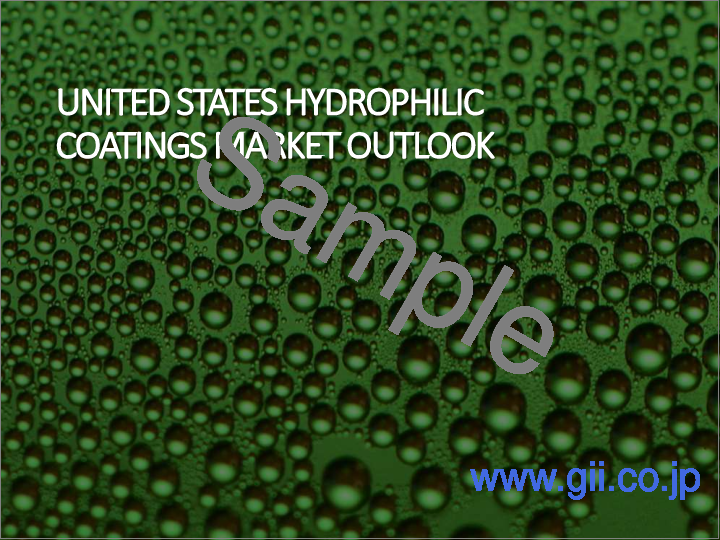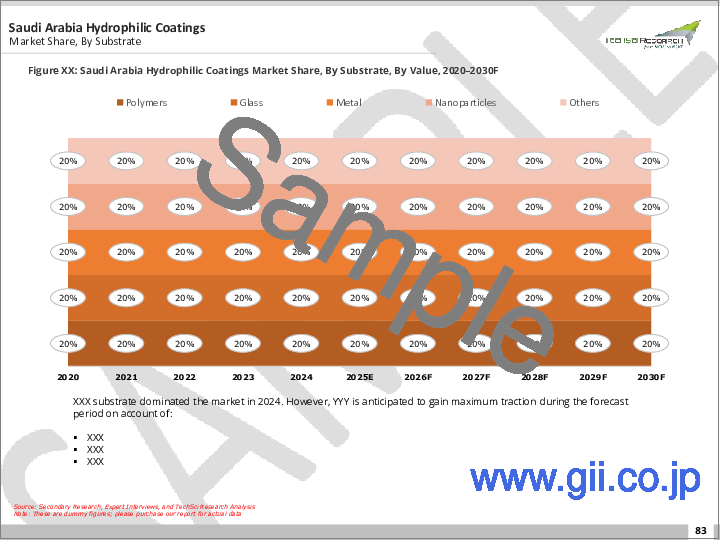|
|
市場調査レポート
商品コード
1667964
親水性コーティング市場- 世界の産業規模、シェア、動向、機会、予測、基材別、用途別、地域別、競合別、2020~2030年Hydrophilic Coatings Market - Global Industry Size, Share, Trends, Opportunity, & Forecast, Segmented By Substrate, By Application, By Region & Competition, 2020-2030F |
||||||
カスタマイズ可能
|
|||||||
| 親水性コーティング市場- 世界の産業規模、シェア、動向、機会、予測、基材別、用途別、地域別、競合別、2020~2030年 |
|
出版日: 2025年02月28日
発行: TechSci Research
ページ情報: 英文 185 Pages
納期: 2~3営業日
|
全表示
- 概要
- 目次
親水性コーティングの世界市場規模は2024年に110億5,000万米ドルとなり、予測期間中は2030年までCAGR5.20%で安定した成長が予測されています。
親水性コーティングは画期的な技術となっており、そのユニークな特性と多様な用途により、複数の業界で大きな支持を得ています。ヘルスケアから消費財に至るまで、技術の進歩、ヘルスケア需要の増加、持続可能性への注目の高まりによって、市場は力強い成長を遂げています。
| 市場概要 | |
|---|---|
| 予測期間 | 2026-2030 |
| 市場規模:2024年 | 110億5,000万米ドル |
| 市場規模:2030年 | 150億1,000万米ドル |
| CAGR:2025年~2030年 | 5.20% |
| 急成長セグメント | ポリマー |
| 最大市場 | アジア太平洋 |
持続可能性を追求する世界の動きは、コーティング分野にも大きな影響を及ぼしており、親水性コーティングも例外ではないです。企業は環境目標を達成するため、環境に優しい配合や製造方法を積極的に追求しています。親水性コーティングの持続可能性の課題への対応力は、環境意識の高まる市場において有利な立場にあります。
親水性コーティング市場は現在、様々な分野でイノベーションと需要が急増しています。技術が進化し続け、産業界が持続可能なソリューションを優先する中、同市場はプラスの成長軌道を維持すると予想されます。Harland Medical Systems, Inc.やBiocoat, Inc.のような企業が先進的な検査システムやディップコーティング装置に進出したことは、親水性コーティングが製品の形成やヘルスケア実践の変革に重要な役割を果たす未来を示唆しています。
市場促進要因
医療機器アプリケーション
主な市場課題
原材料価格の変動
主要市場動向
ヘルスケアにおける需要の高まり
目次
第1章 概要
第2章 調査手法
第3章 エグゼクティブサマリー
第4章 COVID-19が世界の親水性コーティング市場に与える影響
第5章 世界の親水性コーティング市場展望
- 市場規模・予測
- 金額・数量別
- 市場シェア・予測
- 基材別(ポリマー、ガラス、金属、ナノ粒子、その他)
- 用途別(航空宇宙、自動車、海洋、医療機器、その他)
- 地域別
- 企業別(2024)
- 市場マップ
第6章 アジア太平洋地域の親水性コーティング市場展望
- 市場規模・予測
- 市場シェア・予測
- アジア太平洋地域:国別分析
- 中国
- インド
- オーストラリア
- 日本
- 韓国
第7章 欧州の親水性コーティング市場展望
- 市場規模・予測
- 市場シェア・予測
- 欧州:国別分析
- フランス
- ドイツ
- スペイン
- イタリア
- 英国
第8章 北米の親水性コーティング市場展望
- 市場規模・予測
- 市場シェア・予測
- 北米:国別分析
- 米国
- メキシコ
- カナダ
第9章 南米の親水性コーティング市場展望
- 市場規模・予測
- 市場シェア・予測
- 南米:国別分析
- ブラジル
- アルゼンチン
- コロンビア
第10章 中東・アフリカの親水性コーティング市場展望
- 市場規模・予測
- 市場シェア・予測
- 中東・アフリカ:国別分析
- 南アフリカ
- サウジアラビア
- アラブ首長国連邦
第11章 市場力学
- 促進要因
- 課題
第12章 市場動向と発展
- 最近の動向
- 製品上市
- 合併と買収
第13章 世界の親水性コーティング市場:SWOT分析
第14章 ポーターのファイブフォース分析
- 業界内の競合
- 新規参入の可能性
- サプライヤーの力
- 顧客の力
- 代替品の脅威
第15章 PESTEL分析
第16章 価格分析
第17章 競合情勢
- Abbott Laboratories Inc.
- Harland Medical Systems Inc.
- Surmodics Incorporated
- Aculon, Inc.
- Ast Products, Inc.
- Biocoat, Inc.
- Corning Inc.
- Royal DSM
- Hydromer Inc
- Advansource Biomaterials Corporation
第18章 戦略的提言
第19章 調査会社について・免責事項
The global hydrophilic coatings market was valued at USD 11.05 billion in 2024 and is projected to experience steady growth during the forecast period, with a compound annual growth rate (CAGR) of 5.20% through 2030. Hydrophilic coatings have become a revolutionary technology, gaining significant traction across multiple industries due to their unique properties and diverse applications. From healthcare to consumer goods, the market is witnessing strong growth, driven by technological advancements, increasing healthcare demands, and a rising focus on sustainability.
| Market Overview | |
|---|---|
| Forecast Period | 2026-2030 |
| Market Size 2024 | USD 11.05 Billion |
| Market Size 2030 | USD 15.01 Billion |
| CAGR 2025-2030 | 5.20% |
| Fastest Growing Segment | Polymers |
| Largest Market | Asia-Pacific |
The global push for sustainability is having a significant impact on the coatings sector, with hydrophilic coatings being no exception. Companies are actively pursuing eco-friendly formulations and manufacturing methods to meet environmental goals. The ability of hydrophilic coatings to address sustainability challenges positions them favorably in an increasingly green-conscious market.
The hydrophilic coatings market is currently experiencing a surge of innovation and demand across various sectors. As technology continues to evolve and industries prioritize sustainable solutions, the market is expected to maintain a positive growth trajectory. The expansion of companies like Harland Medical Systems, Inc. and Biocoat, Inc. into advanced testing systems and dip coating equipment signals a future where hydrophilic coatings will play a crucial role in shaping products and transforming healthcare practices.
Key Market Drivers
Medical Device Applications
The hydrophilic coatings market is witnessing robust growth, primarily driven by the increasing demand in medical device applications. These coatings, known for their water-attracting properties, are extensively used in the medical industry to enhance the performance, safety, and functionality of various medical devices.
Hydrophilic coatings are applied to medical devices to reduce friction, enhance lubricity, and ensure smoother insertion and operation. This is particularly crucial for devices such as catheters, guidewires, and endoscopes, where minimizing patient discomfort and tissue damage is essential. For instance, urinary, cardiovascular, and neurovascular catheters benefit from hydrophilic coatings to reduce friction during insertion and movement within the body, leading to improved patient comfort and a reduced risk of complications like infections or tissue damage. Coated guidewires are key in minimally invasive surgeries, making navigation through blood vessels and narrow pathways easier. Hydrophilic coatings on endoscopes also improve maneuverability and minimize the risk of tissue damage during diagnostic or surgical procedures.
The growing popularity of minimally invasive surgeries, which depend on these coated devices, is a major factor propelling market growth. Moreover, hydrophilic coatings can be engineered with antimicrobial properties, reducing the risk of infections associated with medical devices. Reports indicate that, despite 71% of countries having established an Infection Prevention and Control (IPC) program, only 6% fully meet the World Health Organization (WHO) IPC standards, with significant gaps in low- and middle-income countries. This highlights the urgent need for better infection control strategies and regulatory measures to improve healthcare safety globally. Hydrophilic coatings, which prevent the growth of bacteria and pathogens on medical devices, are crucial in this context. Their biocompatibility further ensures they do not trigger adverse immune responses, making them vital for infection prevention in healthcare settings.
Key Market Challenges
Fluctuating Raw Material Prices
Hydrophilic coatings, which rely on specialized polymers and compounds, face challenges related to fluctuations in raw material prices. The inherent volatility of these materials poses a significant concern for industry stakeholders. The rising costs of essential raw materials directly impact the production expenses for manufacturers, putting pressure on their profit margins, especially in competitive markets.
Price fluctuations can also disrupt pricing strategies within the hydrophilic coatings market. Increased production costs may compel manufacturers to adjust their pricing, which, in turn, can lead to price wars and further strain profitability. Additionally, sudden changes in the availability of raw materials can disrupt the global supply chain, leading to production delays and potentially damaging customer relationships.
Key Market Trends
Rising Demand in Healthcare
A key driver of the growing demand for hydrophilic coatings is their widespread use in critical medical applications. These coatings are applied to medical devices like catheters, guidewires, and surgical instruments to improve lubricity and reduce friction, enhancing the effectiveness and precision of medical procedures, particularly in delicate interventions.
The increasing adoption of minimally invasive procedures is further fueling the demand for hydrophilic coatings. These procedures offer lower trauma, reduced recovery times, and fewer complications, making them preferable for both patients and healthcare professionals. Hydrophilic coatings facilitate these techniques by enabling devices to navigate biological pathways more easily.
The aging global population is another factor contributing to the rise in demand for healthcare interventions. With more elderly individuals requiring medical treatment, the need for medical devices incorporating hydrophilic coatings has risen. These coatings improve the functionality and performance of medical devices, catering to the specific healthcare needs of the aging demographic.
To meet the growing demand, companies in the hydrophilic coatings market are investing in research and development to enhance coating technologies. An example is the launch of Harland Medical Systems' CTS1100 Coating Thickness Testing System, which ensures precision and quality control, further driving market growth.
Key Market Players
- Abbott Laboratories Inc.
- Harland Medical Systems Inc.
- Surmodics Incorporated
- Aculon, Inc.
- Ast Products, Inc.
- Biocoat, Inc.
- Corning Inc.
- Royal DSM
- Hydromer Inc.
- Advansource Biomaterials Corporation
Report Scope
This report segments the Global Hydrophilic Coatings Market into the following categories, along with the detailed industry trends:
- By Substrate: Polymers, Glass, Metal, Nanoparticles, Others
- By Application: Aerospace, Automotive, Marine, Medical Devices, Others
By Region:
- North America (United States, Canada, Mexico)
- Europe (France, United Kingdom, Italy, Germany, Spain)
- Asia-Pacific (China, India, Japan, Australia, South Korea)
- South America (Brazil, Argentina, Colombia)
- Middle East & Africa (South Africa, Saudi Arabia, UAE)
Competitive Landscape
Company profiles: Detailed analysis of the leading companies in the Global Hydrophilic Coatings Market.
Available Customizations
TechSci Research offers the following customization options for the Global Hydrophilic Coatings Market report:
- Additional detailed analysis and profiling of up to five additional market players.
Table of Contents
1. Product Overview
- 1.1. Market Definition
- 1.2. Scope of the Market
- 1.2.1. Markets Covered
- 1.2.2. Years Considered for Study
- 1.2.3. Key Market Segmentations
2. Research Methodology
- 2.1. Objective of the Study
- 2.2. Baseline Methodology
- 2.3. Key Industry Partners
- 2.4. Major Association and Secondary Sources
- 2.5. Forecasting Methodology
- 2.6. Data Triangulation & Validation
- 2.7. Assumptions and Limitations
3. Executive Summary
- 3.1. Overview of the Market
- 3.2. Overview of Key Market Segmentations
- 3.3. Overview of Key Market Players
- 3.4. Overview of Key Regions/Countries
- 3.5. Overview of Market Drivers, Challenges, Trends
4. Impact of COVID-19 on Global Hydrophilic Coatings Market
5. Global Hydrophilic Coatings Market Outlook
- 5.1. Market Size & Forecast
- 5.1.1. By Value & Volume
- 5.2. Market Share & Forecast
- 5.2.1. By Substrate (Polymers, Glass, Metal, Nanoparticles, Others)
- 5.2.2. By Application (Aerospace, Automotive, Marine, Medical Devices, Others)
- 5.2.3. By Region
- 5.2.4. By Company (2024)
- 5.3. Market Map
6. Asia Pacific Hydrophilic Coatings Market Outlook
- 6.1. Market Size & Forecast
- 6.1.1. By Value & Volume
- 6.2. Market Share & Forecast
- 6.2.1. By Substrate
- 6.2.2. By Application
- 6.2.3. By Country
- 6.3. Asia Pacific: Country Analysis
- 6.3.1. China Hydrophilic Coatings Market Outlook
- 6.3.1.1. Market Size & Forecast
- 6.3.1.1.1. By Value & Volume
- 6.3.1.2. Market Share & Forecast
- 6.3.1.2.1. By Substrate
- 6.3.1.2.2. By Application
- 6.3.1.1. Market Size & Forecast
- 6.3.2. India Hydrophilic Coatings Market Outlook
- 6.3.2.1. Market Size & Forecast
- 6.3.2.1.1. By Value & Volume
- 6.3.2.2. Market Share & Forecast
- 6.3.2.2.1. By Substrate
- 6.3.2.2.2. By Application
- 6.3.2.1. Market Size & Forecast
- 6.3.3. Australia Hydrophilic Coatings Market Outlook
- 6.3.3.1. Market Size & Forecast
- 6.3.3.1.1. By Value & Volume
- 6.3.3.2. Market Share & Forecast
- 6.3.3.2.1. By Substrate
- 6.3.3.2.2. By Application
- 6.3.3.1. Market Size & Forecast
- 6.3.4. Japan Hydrophilic Coatings Market Outlook
- 6.3.4.1. Market Size & Forecast
- 6.3.4.1.1. By Value & Volume
- 6.3.4.2. Market Share & Forecast
- 6.3.4.2.1. By Substrate
- 6.3.4.2.2. By Application
- 6.3.4.1. Market Size & Forecast
- 6.3.5. South Korea Hydrophilic Coatings Market Outlook
- 6.3.5.1. Market Size & Forecast
- 6.3.5.1.1. By Value & Volume
- 6.3.5.2. Market Share & Forecast
- 6.3.5.2.1. By Substrate
- 6.3.5.2.2. By Application
- 6.3.5.1. Market Size & Forecast
- 6.3.1. China Hydrophilic Coatings Market Outlook
7. Europe Hydrophilic Coatings Market Outlook
- 7.1. Market Size & Forecast
- 7.1.1. By Value & Volume
- 7.2. Market Share & Forecast
- 7.2.1. By Substrate
- 7.2.2. By Application
- 7.2.3. By Country
- 7.3. Europe: Country Analysis
- 7.3.1. France Hydrophilic Coatings Market Outlook
- 7.3.1.1. Market Size & Forecast
- 7.3.1.1.1. By Value & Volume
- 7.3.1.2. Market Share & Forecast
- 7.3.1.2.1. By Substrate
- 7.3.1.2.2. By Application
- 7.3.1.1. Market Size & Forecast
- 7.3.2. Germany Hydrophilic Coatings Market Outlook
- 7.3.2.1. Market Size & Forecast
- 7.3.2.1.1. By Value & Volume
- 7.3.2.2. Market Share & Forecast
- 7.3.2.2.1. By Substrate
- 7.3.2.2.2. By Application
- 7.3.2.1. Market Size & Forecast
- 7.3.3. Spain Hydrophilic Coatings Market Outlook
- 7.3.3.1. Market Size & Forecast
- 7.3.3.1.1. By Value & Volume
- 7.3.3.2. Market Share & Forecast
- 7.3.3.2.1. By Substrate
- 7.3.3.2.2. By Application
- 7.3.3.1. Market Size & Forecast
- 7.3.4. Italy Hydrophilic Coatings Market Outlook
- 7.3.4.1. Market Size & Forecast
- 7.3.4.1.1. By Value & Volume
- 7.3.4.2. Market Share & Forecast
- 7.3.4.2.1. By Substrate
- 7.3.4.2.2. By Application
- 7.3.4.1. Market Size & Forecast
- 7.3.5. United Kingdom Hydrophilic Coatings Market Outlook
- 7.3.5.1. Market Size & Forecast
- 7.3.5.1.1. By Value & Volume
- 7.3.5.2. Market Share & Forecast
- 7.3.5.2.1. By Substrate
- 7.3.5.2.2. By Application
- 7.3.5.1. Market Size & Forecast
- 7.3.1. France Hydrophilic Coatings Market Outlook
8. North America Hydrophilic Coatings Market Outlook
- 8.1. Market Size & Forecast
- 8.1.1. By Value & Volume
- 8.2. Market Share & Forecast
- 8.2.1. By Substrate
- 8.2.2. By Application
- 8.2.3. By Country
- 8.3. North America: Country Analysis
- 8.3.1. United States Hydrophilic Coatings Market Outlook
- 8.3.1.1. Market Size & Forecast
- 8.3.1.1.1. By Value & Volume
- 8.3.1.2. Market Share & Forecast
- 8.3.1.2.1. By Substrate
- 8.3.1.2.2. By Application
- 8.3.1.1. Market Size & Forecast
- 8.3.2. Mexico Hydrophilic Coatings Market Outlook
- 8.3.2.1. Market Size & Forecast
- 8.3.2.1.1. By Value & Volume
- 8.3.2.2. Market Share & Forecast
- 8.3.2.2.1. By Substrate
- 8.3.2.2.2. By Application
- 8.3.2.1. Market Size & Forecast
- 8.3.3. Canada Hydrophilic Coatings Market Outlook
- 8.3.3.1. Market Size & Forecast
- 8.3.3.1.1. By Value & Volume
- 8.3.3.2. Market Share & Forecast
- 8.3.3.2.1. By Substrate
- 8.3.3.2.2. By Application
- 8.3.3.1. Market Size & Forecast
- 8.3.1. United States Hydrophilic Coatings Market Outlook
9. South America Hydrophilic Coatings Market Outlook
- 9.1. Market Size & Forecast
- 9.1.1. By Value & Volume
- 9.2. Market Share & Forecast
- 9.2.1. By Substrate
- 9.2.2. By Application
- 9.2.3. By Country
- 9.3. South America: Country Analysis
- 9.3.1. Brazil Hydrophilic Coatings Market Outlook
- 9.3.1.1. Market Size & Forecast
- 9.3.1.1.1. By Value & Volume
- 9.3.1.2. Market Share & Forecast
- 9.3.1.2.1. By Substrate
- 9.3.1.2.2. By Application
- 9.3.1.1. Market Size & Forecast
- 9.3.2. Argentina Hydrophilic Coatings Market Outlook
- 9.3.2.1. Market Size & Forecast
- 9.3.2.1.1. By Value & Volume
- 9.3.2.2. Market Share & Forecast
- 9.3.2.2.1. By Substrate
- 9.3.2.2.2. By Application
- 9.3.2.1. Market Size & Forecast
- 9.3.3. Colombia Hydrophilic Coatings Market Outlook
- 9.3.3.1. Market Size & Forecast
- 9.3.3.1.1. By Value & Volume
- 9.3.3.2. Market Share & Forecast
- 9.3.3.2.1. By Substrate
- 9.3.3.2.2. By Application
- 9.3.3.1. Market Size & Forecast
- 9.3.1. Brazil Hydrophilic Coatings Market Outlook
10. Middle East and Africa Hydrophilic Coatings Market Outlook
- 10.1. Market Size & Forecast
- 10.1.1. By Value & Volume
- 10.2. Market Share & Forecast
- 10.2.1. By Substrate
- 10.2.2. By Application
- 10.2.3. By Country
- 10.3. MEA: Country Analysis
- 10.3.1. South Africa Hydrophilic Coatings Market Outlook
- 10.3.1.1. Market Size & Forecast
- 10.3.1.1.1. By Value & Volume
- 10.3.1.2. Market Share & Forecast
- 10.3.1.2.1. By Substrate
- 10.3.1.2.2. By Application
- 10.3.1.1. Market Size & Forecast
- 10.3.2. Saudi Arabia Hydrophilic Coatings Market Outlook
- 10.3.2.1. Market Size & Forecast
- 10.3.2.1.1. By Value & Volume
- 10.3.2.2. Market Share & Forecast
- 10.3.2.2.1. By Substrate
- 10.3.2.2.2. By Application
- 10.3.2.1. Market Size & Forecast
- 10.3.3. UAE Hydrophilic Coatings Market Outlook
- 10.3.3.1. Market Size & Forecast
- 10.3.3.1.1. By Value & Volume
- 10.3.3.2. Market Share & Forecast
- 10.3.3.2.1. By Substrate
- 10.3.3.2.2. By Application
- 10.3.3.1. Market Size & Forecast
- 10.3.1. South Africa Hydrophilic Coatings Market Outlook
11. Market Dynamics
- 11.1. Drivers
- 11.2. Challenges
12. Market Trends & Developments
- 12.1. Recent Developments
- 12.2. Product Launches
- 12.3. Mergers & Acquisitions
13. Global Hydrophilic Coatings Market: SWOT Analysis
14. Porter's Five Forces Analysis
- 14.1. Competition in the Industry
- 14.2. Potential of New Entrants
- 14.3. Power of Suppliers
- 14.4. Power of Customers
- 14.5. Threat of Substitute Product
15. PESTLE Analysis
16. Pricing Analysis
17. Competitive Landscape
- 17.1. Abbott Laboratories Inc.
- 17.1.1. Business Overview
- 17.1.2. Company Snapshot
- 17.1.3. Products & Services
- 17.1.4. Financials (As Reported)
- 17.1.5. Recent Developments
- 17.2. Harland Medical Systems Inc.
- 17.3. Surmodics Incorporated
- 17.4. Aculon, Inc.
- 17.5. Ast Products, Inc.
- 17.6. Biocoat, Inc.
- 17.7. Corning Inc.
- 17.8. Royal DSM
- 17.9. Hydromer Inc
- 17.10. Advansource Biomaterials Corporation




